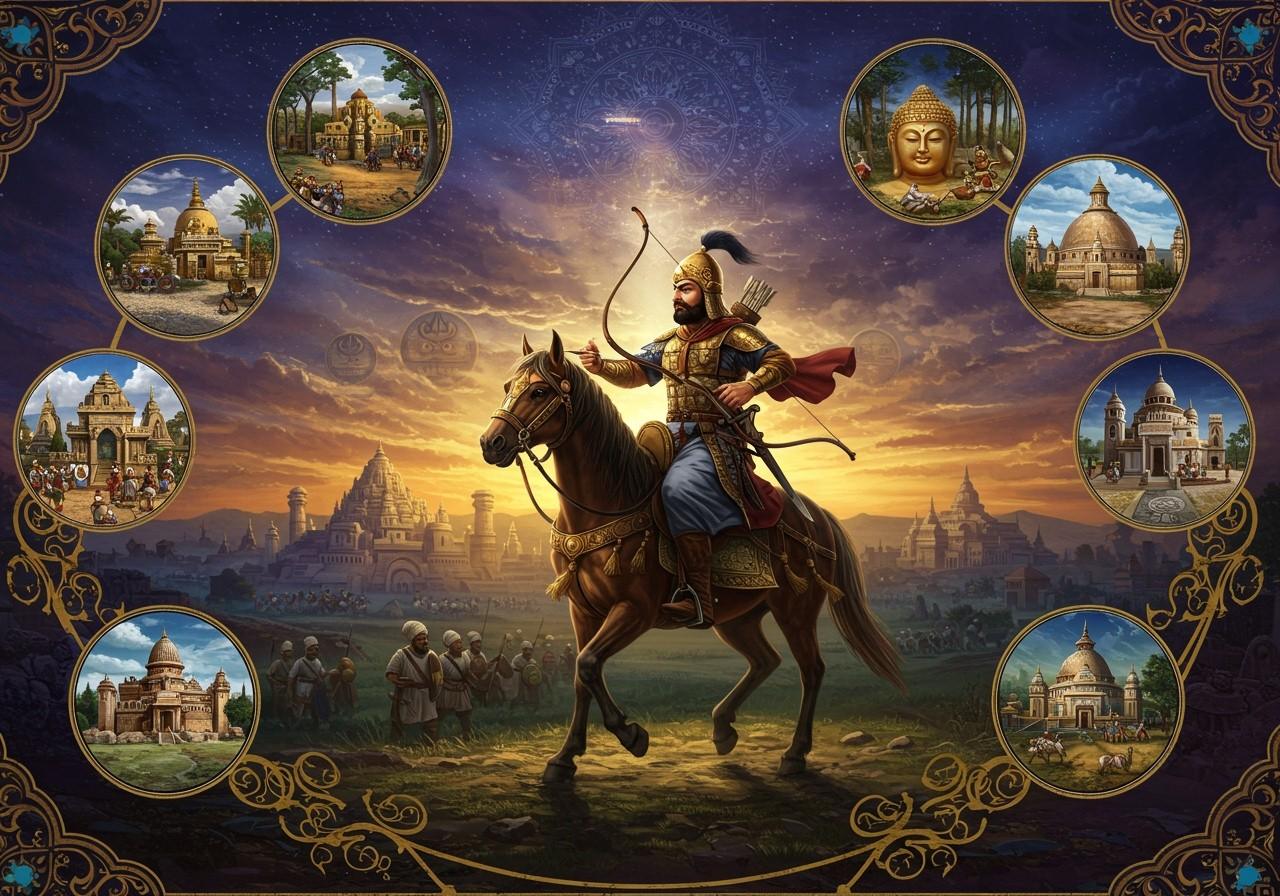
The history of ancient India is a captivating narrative of empires, conquests, and cultural fusion. From the Indus Valley Civilization (c. 3300 BCE) to the Gupta Empire’s “Golden Age” (4th-6th century CE), the subcontinent witnessed a dynamic interplay of power. Within this historical panorama, the Sakas emerged as a significant force, leaving their mark on the region’s cultural and political landscape. This blog post delves into the history of the Sakas, exploring their interactions with other prominent empires like the Kushans, Parthians, Hunas, and Satavahanas. We will also examine key figures and events that defined this era, providing valuable insights for those interested in Indian history and heritage.
The Sakas: An Overview
The Sakas, also known as Scythians, were nomadic tribes originating from Central Asia. Around the 2nd century BCE, they migrated into the Indian subcontinent, establishing kingdoms in the northwestern regions, primarily in present-day Gujarat and Rajasthan. Their arrival brought distinct cultural and military influences, enriching the already diverse tapestry of the region. Over time, the Sakas integrated into the broader Indian cultural milieu, contributing to its vibrant complexity. Their presence coincided with other significant periods, such as the Greco-Bactrian conquests (c. 200 BCE) and the rise of empires like the Mauryas (founded 322 BCE).
Interactions with Other Empires
The Sakas interacted with various other powerful empires during their time in India. These interactions often involved both conflict and cooperation, shaping the political dynamics of the subcontinent.
The Kushans
The Kushans, another Central Asian tribe, entered India around the same period as the Sakas. Their empire, under rulers like Kanishka, encompassed northern India. The Sakas and Kushans engaged in both battles and alliances, leading to significant cultural exchange, particularly in art, religion, and trade. This period of interaction contributed to the flourishing of artistic styles and religious practices in the region.
The Parthians
The Parthians, hailing from Iran, also interacted with the Sakas, forming political and military alliances. The Indo-Parthian Kingdom played a crucial role in shaping the socio-political landscape. Notable rulers like Gondophares facilitated cultural amalgamation between the two groups. This interaction further diversified the cultural landscape of the region.
The Hunas and Huns
The Hunas invaded India in the 5th century CE, a period towards the end of the Gupta Empire (c. 550 CE). Conflicts between the Sakas and Hunas resulted in significant battles and territorial shifts. The Huna invasions weakened the Sakas and contributed to their decline. The Huns, often confused with the Hunas, were another nomadic tribe from Central Asia, adding to the complex web of interactions in the region. Their presence further destabilized the existing power structures.
The Satavahanas
The Satavahanas ruled southern and central India contemporaneously with the Sakas. Gautamiputra Satakarni, a prominent Satavahana ruler, engaged in numerous conflicts with the Sakas. These battles were pivotal in determining regional dominance. Gautamiputra Satakarni’s victory over the Saka ruler Nahapana marked a turning point, consolidating Satavahana power and weakening the Saka presence. This victory significantly impacted the power dynamics in the Deccan region and beyond.
The Decline of the Sakas
The decline of the Sakas resulted from a confluence of factors. The sustained resistance from Indian rulers, particularly the Satavahanas, played a crucial role. Internal conflicts and alliances with other groups further weakened their position. Eventually, larger Indian empires absorbed the Saka territories, integrating them into the broader Indian polity. This integration left a lasting legacy, with remnants of Saka influence evident in various aspects of Indian culture and society.
Religious Practices and Rituals
The ancient Indian empires, including the Sakas, observed rich religious traditions that continue to resonate in modern Hindu practices. Poojn.in offers a wide array of authentic puja items, connecting individuals to these ancient rituals. Whether you seek items for worshipping Lord Kartikeya, Lord Ganesha, Garuda, Lord Indra, or Lord Shiva, Poojn.in provides a comprehensive collection to support your devotional practices. Visit Poojn.in today to explore our diverse selection of puja essentials.
- Lord Kartikeya: Find kumkum, haldi, and special incense sticks for traditional Kartikeya puja, reminiscent of ancient martial traditions. Shop for incense sticks here.
- Lord Ganesha: Perform Ganesha puja with authentic modak offerings, red flowers, and durva grass, available through our online platform. Learn more about essential puja items.
- Garuda: Conduct Garuda puja with specific dhoop and deep (lamp) materials aligned with traditional specifications. Explore related products.
- Lord Indra: Obtain complete puja thalis and materials for Lord Indra puja, including white flowers, pure ghee, and specific incense types. Browse our collection of puja accessories.
- Lord Shiva: Explore an extensive collection of Shaivite puja items, including bilva leaves, rudraksha malas, and abhisheka materials. Find Shiva lingams and more.
Conclusion
The history of the Sakas and other ancient Indian empires reveals a rich and complex past. Their interactions, conflicts, and eventual integration into the Indian subcontinent shaped the cultural, political, and social fabric of the region. Understanding this history allows us to appreciate the diverse heritage that has shaped modern India. By exploring these narratives, we connect with our roots and ensure the preservation of these traditions for generations to come.


